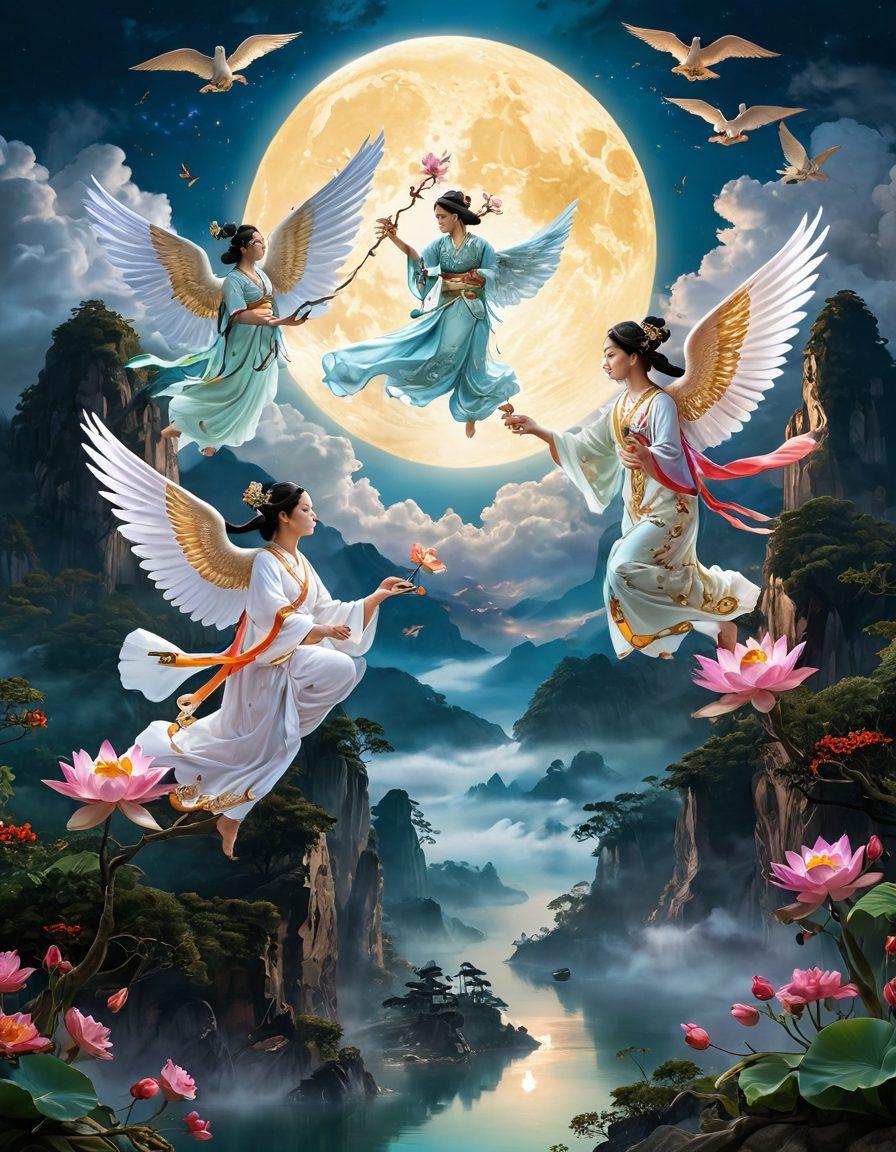Exploring the Divine: The Role of Asian Angels in Mythology and Spirituality
In the heart of Asia lies an intricate tapestry of culture and spirituality, woven with tales of Asian angels that transcend time and borders. These celestial entities are not mere figments of imagination; they are deeply entrenched in the collective consciousness of various communities across the region. Why do these divine beings resonate so powerfully within Asian culture? What roles do they play in shaping our narratives, offering wisdom, guidance, and a glimpse into the heavenly realms? Let's journey through the mystical landscapes of East Asian and Southeast Asian traditions to uncover how these angelic figures illuminate the paths of humankind.
Imagine a temple adorned with intricate carvings of cherubs and divine beings, each telling a story that connects the physical with the metaphysical. In Asian mythology, angels often embody the virtues and ideals of their cultures. They are seen as guardians who protect the innocent, champions of justice, and messengers of peace. As we delve into these enchanting tales, we cannot help but question: How do these cultural icons reflect the societal values and beliefs of their times? Through storytelling, we discover that these heavenly beings are not just protectors; they are mirrors to our own aspirations and fears, guiding us toward a higher purpose.
In the vibrant world of Asian spirituality, angels take on many forms, often blending seamlessly with Asian deities and mythical creatures. For instance, the Buddhist concept of 'Tāla' represents celestial beings who guide souls through the realms of existence. They are depicted as beautiful, benevolent figures with a divine aura, serving as spiritual guides in the afterlife. The question arises: How do these Asian angels inspire individuals to seek enlightenment and a deeper understanding of themselves? Through their presence in folklore, they remind us to cultivate compassion and mindfulness while navigating the complexities of life.
Across various Asian cultures, the concept of Asian angels manifests in unique ways. Take, for example, the Japanese belief in 'Shinto' spirits, or 'Kami,' which emphasize the interconnectedness of all beings, both human and divine. These spiritual beings are revered as nature’s guardians, encouraging a sense of harmony within the environment. As we consider this interplay of Asian culture and spirituality, we might ask ourselves: How can we embody the qualities of these celestial guardians in our daily lives? By embracing environmental stewardship and promoting peace, we can effectively honor the legacies of these transcendent beings.
From the silk-laden streets of Asia to the towering temples not only lies a rich repository of tales but also lessons steeped in wisdom passed through generations. As we unveil the mystique of Asian angels in mythology, we find that they are not just figments of imagination—they are essential elements of our cultural narratives. They inspire hope and foster a sense of belonging in an ever-changing world. So, as we continue to celebrate these divine beings, let us reflect on the stories they tell, the guardians they represent, and the spiritual journeys they inspire within us. What aspect of the Asian angel narrative resonates most with you? Be it the protective nature of the cherubs or the transcendental wisdom of the deities, let's carry these rich traditions forward, much like the stories that have shaped our world for centuries.
Celestial Guardians: The Intersection of Asian Mythology and Spirituality
In the rich tapestry of Asian mythology and spirituality, we often find ourselves enchanted by the myriad of divine beings that shape the beliefs and cultures of this diverse region. Among these celestial figures are angels, well-known in Western traditions but perhaps less understood in an Asian context. This juxtaposition prompts intriguing questions about our understanding of spirituality. How do these divine guardians, often depicted as cherubs or angelic figures, manifest differently across various cultures? As we unravel the mysteries of Asian angels, we come closer to understanding the essence of these transcendent beings and their significance in the lives of those who revere them.
Asian mythology is a treasure trove of cultural icons that have captivated countless generations. From East Asian dragons to Southeast Asian spirits, each encounter with these mythical creatures offers insight into the values and beliefs of the people who created them. Asian angels, much like their Western counterparts, are seen as celestial entities tasked with guiding, protecting, and nurturing humanity. But what does it mean to encounter an Asian angel? How do these heavenly beings resonate with the powerful narratives of benevolence and guardianship in spirituality? As we dig deeper, we find that these divine creatures are not just figures of worship, but also reflect the complexities and challenges of the human experience.
Consider the tenets of Asian spirituality, where the blend of reverence for nature and the recognition of spiritual beings expands our understanding of life and existence. In various Oriental traditions, angels can be recognized in the form of benevolent deities or other spiritual beings, serving both as guardians and guides. This enhances the narrative of nature in spirituality, intertwining the earthly with the divine. Think about the Kuan Yin in Chinese culture, often seen as a goddess of mercy and compassion, embodying the attributes of an angelic being while rooted deeply in human experience. What aligns her to the ideals an Asian angel must uphold, and how does this reflect on Asian culture as a whole?
The stories told through Asian mythology deliver not just tales of the past but potent life lessons veiled in the symbolism of divine beings. For instance, in Hindu traditions, the concept of guardian angels is embodied in the wishes of deities such as Ganesha and Lakshmi, who provide protection and prosperity respectively. They serve as reminders of the values of wisdom, abundance, and ethical living. Engaging with these angelic figures offers an opportunity for deeper reflection on one's journey, transformation, and spiritual growth. How can these messages from the divine inspire us in our daily lives? What lessons can we embrace to lead a more fulfilling life?
Navigating the intersection of Asian mythology and spirituality reveals how the role of celestial guardians has evolved and adapted through centuries. These angelic figures are both reflections of the cultural spirit and conduits connecting humanity with the divine. In many cultures, these spiritual beings are not just figures in stories, but part of the lived experience, echoing the love, strength, and hope that communities draw from. By understanding the nuances of Asian angels, we find avenues to appreciate the diversity of beliefs across cultures while recognizing our shared human desire for protection, guidance, and connection to something greater. As we ponder on this vibrant intersection, we invite readers to explore their own paths, embrace the guardians around them, and discover the sacredness that lies within all corners of Asian spirituality.
Angelic Figures in the East: A Journey Through Divine Beings in Asian Lore
When we think of angels, the serene images of cherubs with delicate wings and soft expressions often come to mind. However, this notion predominantly rooted in Western culture doesn't encompass the rich tapestry of angelic figures found in Asian mythology. As we embark on a journey through the East, we'll uncover the fascinating world of Asian angels and their role as divine beings and guardians. What if I told you that these celestial entities have been celebrated as cultural icons for centuries, each carrying unique qualities that reflect the spiritual beliefs of their respective cultures?
From the majestic figures found in Southeast Asian lore to the ethereal spirits revered in East Asian traditions, the diversity of angelic figures in Asian spirituality reveals a profound connection between humanity and the divine. Buddhism, for example, introduces us to a host of transcendent beings known as Bodhisattvas—angels of compassion and wisdom who guide souls toward enlightenment. Meanwhile, Hindu mythology presents the Devas, divine beings associated with various aspects of life, each offering protection and blessings to devotees. This realization prompts an intriguing question: How do these spiritual beings impact our understanding of guardianship and moral values within Asian culture?
Consider the benevolent Guanyin from East Asian beliefs, oftentimes referred to as the Goddess of Mercy. Her presence in temples around Asia serves as a reminder of compassion and kindness in human conduct. It's captivating to see how these angelic figures serve not just as protectors but also as teachers, embodying the virtues we aspire to reflect in our lives. “To save one life is to save the world,” Guanyin embodies this ethos, teaching us about the intrinsic value of compassion. How can we apply these lessons in our daily lives, nurturing kindness in an often chaotic world?
The cultural significance of these Asian angels extends far into the fabric of society, influencing art, literature, and rituals. In Japan, the spirits of Shinto, such as Kami, transcend the boundaries separating the divine from the mundane, drawing a direct line between cultural heritage and spirituality. Furthermore, as we examine these narratives, we see how they shape societal values, illustrating the importance of balance and harmony in daily life. The rich stories of these divine beings are not just enchanting; they hold the keys to understanding the values that underpin various Asian cultures and their spirituality.
In exploring Asian mythology, we uncover a treasure trove of mythical creatures, each a manifestation of the divine. Whether it's the dragons of Chinese lore symbolizing strength and wisdom or the garuda, a divine bird from Southeast Asian tradition, these celestial entities remind us of humanity's eternal quest for connection with higher powers. They inspire us to contemplate our own beliefs and the guardians we choose to welcome into our lives. As we celebrate these angelic figures, we invite their unwavering support and profound guidance into our spiritual journeys, helping us find our place in the ever-expanding cosmos.


